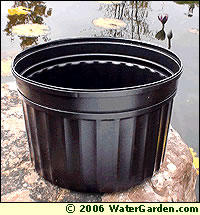Choosing Soil and Pots for Aquatic Plants
Pots
There are several types of pots that can be used when planting aquatic plants into a water garden. While many can work, some may be better than others. The best way to choose what is right for your plants is to know the differences.
Pots With Drainage Holes. These pots can be plastic, terracotta, etc. This is the standard pot typically used in the planting of terrestrial plants. Terrestrial plants need the drainage holes to allow water to drain out. This is not needed with aquatics. When used in the pond, the holes can allow the soil to leech out into the pond water. This can make a mess of the pond and provide nutrient for algae growth. These are cheap but not designed for use in the water garden.
 Baskets. Basket-type containers are a plastic mesh. The downside of these is the same as pots with holes, the open areas in the pots allow the soil from within the pot to leech out into the pond water. In a planting basket the plant can benefit from the nutrients in the water which can more easily be used by the plant in this type of pot. While the plants, can still remain very healthy it is not the best option for the pond in general.
Baskets. Basket-type containers are a plastic mesh. The downside of these is the same as pots with holes, the open areas in the pots allow the soil from within the pot to leech out into the pond water. In a planting basket the plant can benefit from the nutrients in the water which can more easily be used by the plant in this type of pot. While the plants, can still remain very healthy it is not the best option for the pond in general.
No-Hole Pots . There are 2 main types of pots used with aquatic plants. The first of these are the no-hole pots. No-hole pots are usually plastic. These are made specifically for water garden plants. Only the top of the pot is open, so with a top layer of gravel the soil remains where it should in the pot. No-hole pots are easy to use and easy to move around. If using no-hole pots, it is critical that the water level never drop below the top of the pot.
Fabric Pots . This is the second of the preferred water garden pot types. Fabric pots combine the best features of no-hole pots and baskets. The fabric is woven tight enough that it is not going to allow well-packed soil to leech into the pond, while still being open enough to allow the plant to pull extra nutrients directly from the water. Fabric pots are also variable in height, as if the pot is too tall, you can simply roll the edges down to the desired height. The flexible bottom will also allow the pot to sit more level even if the pond bottom is not level. The only downsides of the fabric pots are that they cost a little more and are more difficult to move around outside the pond.
Soil
Like pots, there are many types of soil. Soil has two main purposes; anchoring the plant and holding nutrient. How each soil performs these 2 functions is the biggest determinant is selecting your soil, although cost and availability are certainly factors as well.
Clay Soil. Clay soil is one of the best options for aquatic plants. It holds nutrients and anchors all plants very well. However, too heavy of a clay concentration in the soil can reduce healthy root growth. If available, this garden soil could be dug up from your yard or occasionally purchased.
Sand. Sand can anchor shorter plants well, but not tall plants. It will hold some nutrient but not as well as a clay-based garden soil.
Gravel. Gravel can be used for short plants, but is very poor at nutrient retention. Gravel can work when the plants are for filtration purposes, but any fertilization, will just be released into the water.
Packaged Aquatic Soil . Aquatic soil is usually made up of kiln-fired clay particles. It is a great choice for aquatic plants as it holds nutrients well and provides a strong base for anchoring plants.
Potting Soil. Bagged potting soil is not an acceptable soil for the water garden. It is too light and usually contains too many organics.
Fiber. Fiber rolls and block such as rockwool or coconut fiber can be used for some plantings. However, they are very poor for nutrient retention and also will only anchor short plants.
To summarize, the best combinations of pots and soil for most pond plants would be a no-hole plastic pot or fabric pond pot filled with either clay-based top soil or packaged aquatic soil.
See our potting supplies here.

